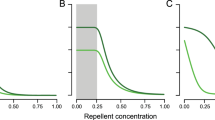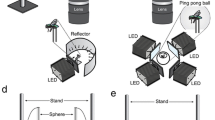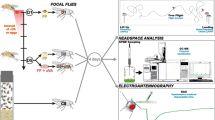Abstract
The fruit fly, Drosophila melanogaster Meigen (Diptera: Drosophilidae), is a model for how animals sense, discriminate, and respond to chemical signals. However, with D. melanogaster our knowledge of the behavioral activity of olfactory receptor ligands has relied largely on close-range attraction, rather than on long-range orientation behavior. We developed a flight assay to relate chemosensory perception to behavior. Headspace volatiles from vinegar attracted 62% of assayed flies during a 15-min experimental period. Flies responded irrespective of age, sex, and mating state, provided they had been starved. To identify behaviorally relevant chemicals from vinegar, we compared the responses to vinegar and synthetic chemicals. Stimuli were applied by a piezoelectric sprayer at known and constant release rates. Re-vaporized methanol extracts of Super Q-trapped vinegar volatiles attracted as many flies as vinegar. The main volatile component of vinegar, acetic acid, elicited significant attraction as a single compound. Two other vinegar volatiles, 2-phenyl ethanol and acetoin, produced a synergistic effect when added to acetic acid. Geosmin, a microbiological off-flavor, diminished attraction to vinegar. This wind tunnel assay based on a conspicuous and unambiguous behavioral response provides the necessary resolution for the investigation of physiologically and ecologically relevant odors and will become an essential tool for the functional analysis of the D. melanogaster olfactory system.


Similar content being viewed by others
References
Allen, M. J., Godenschwege, T. A., Tanouye, M. A., and Phelan, P. 2006. Making an escape: development and function of the Drosophila giant fibre system. Semin. Cell Dev. Biol. 17:31–41.
Andersson, S., Nilsson, L. A., Groth, I., and Bergström, G. 2002. Floral scents in butterfly-pollinated plants: possible convergence in chemical composition. Bot. J. Linn. Soc. 140:129–153.
Asahina, K., Louis, M., Piccinotti, S., and Vosshall, L. B. 2009. A circuit supporting concentration-invariant odor perception in Drosophila. J. Biol. 8:9.
Baker, T. C., Fadamiro, H. Y., and Cossé, A. A. 1998. Moth uses fine tuning for odor resolution. Nature 393:530.
Bartelt, R. J., Schaner, A. M., and Jackson, L. L. 1985. cis-Vaccenyl acetate as an aggregation pheromone in Drosophila melanogaster. J. Chem. Ecol. 11:1747–1756.
Benton, R., Vannice, K. S., and Vosshall, L. B. 2007. An essential role for a CD36-related receptor in pheromone detection in Drosophila. Nature 450:289–293.
Budick, S. A. and Dickinson, M. H. 2006. Free-flight responses of Drosophila melanogaster to attractive odors. J. Exp. Biol. 209:3001–3017.
Card, G. and Dickinson, M. H. 2008. Visually mediated motor planning in the escape response of Drosophila. Curr. Biol. 18:1300–1307.
Chow, D. M. and Frye, M. A. 2008. Context-dependent olfactory enhancement of optomotor flight control in Drosophila. J. Exp. Biol. 211:2478–2485.
Cobb, M. 1999. What and how do maggots smell? Biol. Rev. 74:425–459.
Cocchi, M., Durante, C., Grandi, M., Manzini, D., and Marchetti, A. 2008. Three-way principal component analysis of the volatile fraction by HS-SPME/GC of aceto balsamico tradizionale of modena. Talanta 74:547–554.
Couto, A., Alenius, M., and Dickson, B. J. 2005. Molecular, anatomical, and functional organization of the Drosophila olfactory system. Curr. Biol. 15:1535–1547.
De Bruyne, M. and Baker, T. C. 2008. Odor detection in insects: volatile codes. J. Chem. Ecol. 34:882–897.
De Bruyne, M., Foster, K., and Carlson, J. R. 2001. Odor coding in the Drosophila antenna. Neuron 30:537–552.
Dickson, B. J. 2008. Wired for sex: the neurobiology of Drosophila mating decisions. Science 322:904–909.
El-Sayed, A. M. 2009. The pherobase: Database of insect pheromones and semiochemicals. http://www.pherobase.com/.
El-Sayed, A., Gödde, J., and Arn, H. 1999. Sprayer for quantitative application of odor stimuli. Environ. Entomol. 28:947–953.
Fischler, W., Kong, P., Marella, S., and Scott, K. 2007. The detection of carbonation by the Drosophila gustatory system. Nature 448:1054–1058.
Fishilevich, E., and Vosshall, L. B. 2005. Genetic and functional subdivision of the Drosophila antennal lobe. Curr. Biol. 15:1548–1553.
Fujii, S., Parthasarathy, K., Hardin, P., and Amrein, H. 2007. Nocturnal male sex drive in Drosophila. Curr. Biol. 17:244–251.
Guerrero, E. D., Marin, R. N., Mejias, R. C., and Barroso, C. G. 2007. Stir bar sorptive extraction of volatile compounds in vinegar: validation study and comparison with solid phase microextraction. J. Chromatogr. A 1167:18–26.
Hallem, E. A. and Carlson, J. R. 2006. Coding of odors by a receptor repertoire. Cell 125:143–160.
Hoffmann, A. A. and Parsons, P. A. 1984. Olfactory response and resource utilization in Drosophila: interspecific comparisons. Biol. J. Lin. Soc. 22:43–53.
Inoshita, T. and Tanimura, T. 2008. Cellular identification of water gustatory receptor neurons and their central projection pattern in Drosophila. Proc. Natl. Acad. Sci. USA 103:1094–1099.
Jefferis, G. S. X. E., Potter, C. J., Chan, A. M., Marin, E. C., Rohlfing, T., Maurer, C. R., and Luo, L. 2007. Comprehensive maps of Drosophila higher olfactory centers: spatially segregated fruit and pheromone representation. Cell 128:1187–1203.
Joseph, R. M., Devineni, A., King, I. F. G., and Heberlein U. 2009. Oviposition preference for and positional avoidance of acetic acid provide a model for competing behavioral drives in Drosophila. PNAS 106:11352–11357.
La Guerche, S., Dauphi, B., Pons, M., Dominique, B., and Darriet, P. 2006. Characterization of some mushroom and earthy off-odors microbially induced by the development of rot on grapes. J. Agric. Food Chem. 54:9193–9200.
Landolt, P. J. 2000. New chemical attractants for trapping Lacanobia subjuncta, Mamestra configurata, and Xestia c-nigrum (Lepidoptera: Noctuidae). J. Econ. Entomol. 93:101–106.
Liu, L., Li, Y., Wang, R., Yin, C., Dong, Q., Hing, H., Kim, C., and Welsh, M. J. 2007. Drosophila hygrosensation requires the TRP channels water witch and nanchung. Nature 450:294–299.
Root, C. M., Masuyama, K., Green, D. S., Enell, L. E., Nässel, D. R., Lee, C.-H., and Wang, J. W. 2008. A presynaptic gain control mechanism fine-tunes olfactory behavior. Neuron 59:311–321.
Ruebenbauer, A., Schlyter, F., Hansson, B. S., Löfstedt, C., and Larsson, M. C. 2008. Genetic variability and robustness of host odor preference in Drosophila melanogaster. Curr. Biol. 18:1438–1443.
Schlief, M. L. and Wilson, R. I. 2007. Olfactory processing and behavior downstream from highly selective receptor neurons. Nat. Neurosci. 10:623–630.
Semmelhack, J. L. and Wang, J. W. 2009. Select Drosophila glomeruli mediate innate olfactory attraction and aversion. Nature 459:218–224.
Shang, Y., Claridge-Chang, A., Sjulson, L., Pypaert, M., and Miesenböck, G. 2007. Excitatory local circuits and their implications for olfactory processing in the fly antennal lobe. Cell 128:601–612.
Stensmyr, M. C., Giordano, E., Balloi, A., Angioy, A. M., and Hansson, B. S. 2003. Novel natural ligands for Drosophila olfactory receptor neurones. J. Exp. Biol. 206:715–724.
Tanoue, S., Krishnan, P., Chatterjee, A., and Hardin, P. E. 2008. G protein-coupled receptor kinase 2 is required for rhythmic olfactory responses in Drosophila. Curr. Biol. 18:787–794.
Tasin, M., Bäckman, A.-C., Bengtsson, M., Varela, N., Ioriatti, C., and Witzgall, P. 2006. Wind tunnel attraction of grapevine moth females, Lobesia botrana, to natural and artificial grape odour. Chemoecology 16:87–92.
Trimarchi, J. R. and Schneiderman, A. M. 1995. Different neural pathways coordinate Drosophila flight initiations evoked by visual and olfactory stimuli. J. Exp. Biol. 198:1099–1104.
Vosshall, L. B. and Stocker, R. E. 2007. Molecular architecture of smell and taste in Drosophila. Annu. Rev. Neurosci. 30:505–533.
Zeppa, G., Giordano, M., Gerbi, V., and Meglioli, G. 2002. Characterisation of volatile compounds in three acetification batteries used for the production of “Aceto Balsamico Tradizionale di Reggio Emilia”. Ital. J. Food. Sci. 14:247–266.
Zhu, J., Park, K.-C., and Baker, T. C. 2003. Identification of odors from overripe mango that attract vinegar flies, Drosophila melanogaster. J. Chem. Ecol. 29:899–909.
Acknowledgments
This study was supported by the Linnaeus initiative “Insect Chemical Ecology, Ethology and Evolution” IC-E3 (Formas, SLU). We thank Teun Dekker and Mattias Larsson for helpful comments and discussions. Jörgen Lantz constructed the wind tunnel.
Author information
Authors and Affiliations
Corresponding author
Rights and permissions
About this article
Cite this article
Becher, P.G., Bengtsson, M., Hansson, B.S. et al. Flying the Fly: Long-range Flight Behavior of Drosophila melanogaster to Attractive Odors. J Chem Ecol 36, 599–607 (2010). https://doi.org/10.1007/s10886-010-9794-2
Received:
Revised:
Accepted:
Published:
Issue Date:
DOI: https://doi.org/10.1007/s10886-010-9794-2




